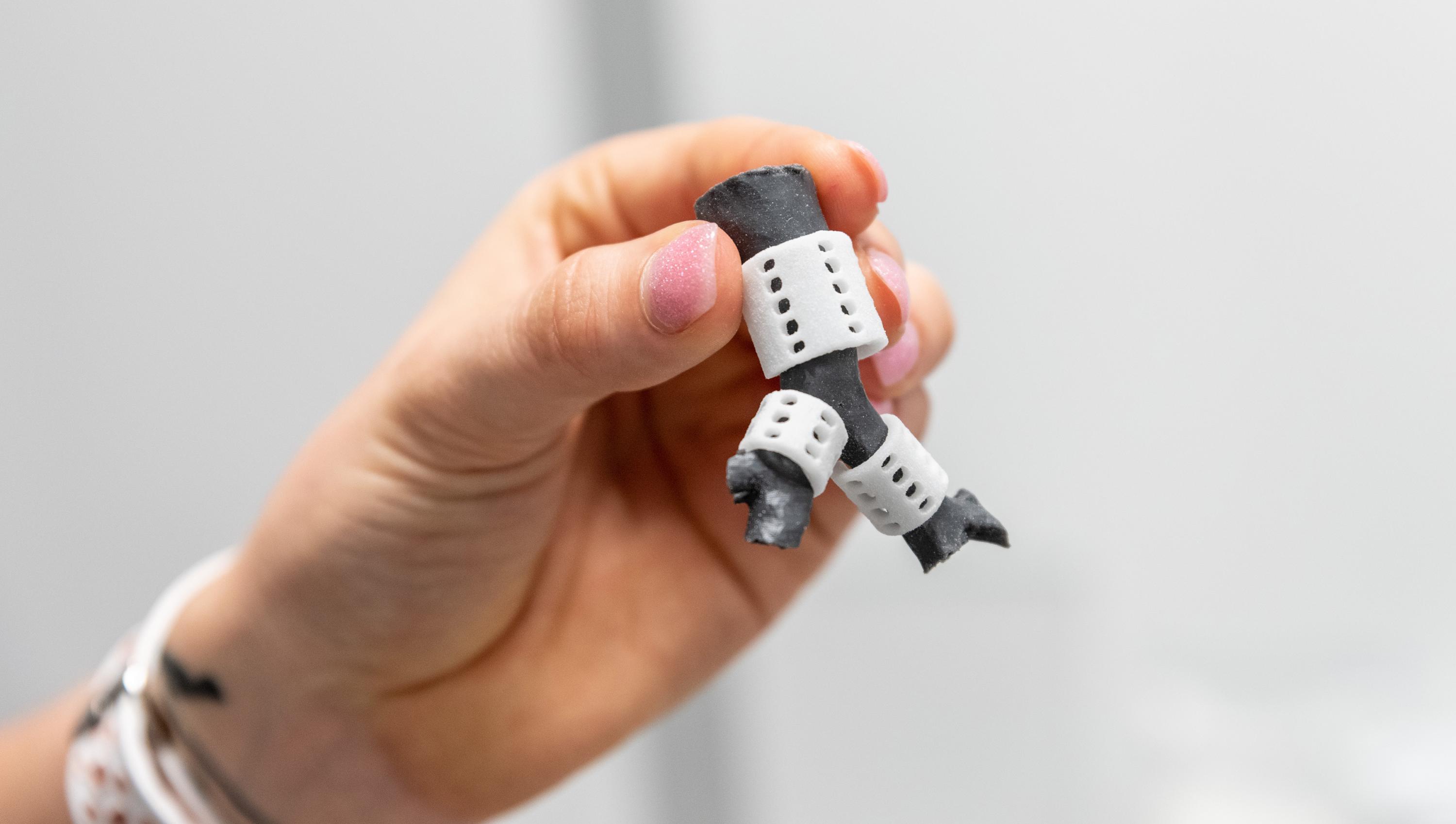3D-Printed Tracheal Splints Used in Groundbreaking Pediatric Surgery

3D printed tracheal splints are shown around a model of a patient’s trachea. The splints are designed to be absorbed into the body, allowing for expansion of the trachea and bronchus. (Credit: Rob Felt, Georgia Tech)
Children’s Healthcare of Atlanta has performed Georgia’s first-ever procedure to place 3D-printed tracheal splints in a pediatric patient. A cross-functional team of Children’s surgeons used three custom-made splints, which biomedical engineers at the Georgia Institute of Technology helped create using an innovative and experimental 3D-printing technology, to assist the breathing of a 7-month-old patient battling life-threatening airway obstruction.
"We are so fortunate to work with a leading engineering school like Georgia Tech to find innovative, potentially life-saving treatment options for our patients,” said Donna Hyland, president and CEO, Children’s Healthcare of Atlanta. “This is a great example of how aligning Children’s clinical expertise with the missions of our research collaborators can improve patient outcomes. Research that can be translated into more effective care at the bedside is why our collaboration with Georgia Tech is so important for the future of pediatric care in Georgia.”
The patient who received the groundbreaking surgery is a 7-month-old boy battling both congenital heart disease and tracheo-bronchomalacia, a condition that causes severe life-threatening airway obstruction. During his six-month inpatient stay in the Pediatric Intensive Care Unit at Children’s, he experienced frequent episodes of airway collapse that could not be corrected by typical surgery protocols. The clinical team proposed surgically inserting an experimental 3D-printed tracheal splint, which is a novel device still in development, to open his airways and expand the trachea and bronchus.
Scott Hollister, Ph.D., who holds the Patsy and Alan Dorris Endowed Chair in Pediatric Technology, a joint initiative supported by Georgia Tech and Children’s Healthcare of Atlanta, developed the process for creating the tracheal splint using 3D printing technology at University of Michigan C.S. Mott Children’s Hospital prior to joining Georgia Tech. The Children’s procedure was the 15th time a 3D-printed tracheal splint was placed in a pediatric patient.
“The possibility of using 3D printing technology to save the life of a child is our motivation in the lab every day,” said Hollister, who is also the director of the Center for 3D Medical Fabrication at Georgia Tech and a professor in the Wallace H. Coulter Department of Biomedical Engineering at Georgia Tech and Emory University. “We’re determined to develop innovative solutions that meet the needs of Georgia’s most complex pediatric patients.”
The splints were created using reconstructions of the patient’s airways from CT scans. Hollister and his team of biomedical engineers collaborated with the Global Center for Medical Innovation (GCMI) so that GCMI could create multiple versions of the splint, of varying sizes, to ensure the perfect fit was available for the surgical team to select and place around the patient’s airways during surgery. GCMI will also support the ongoing development and commercialization of the technology.
In a complex 10-hour surgery, Children’s cross-functional team of surgeons successfully placed three 3D-printed splints around the patient’s trachea on the morning of August 17, 2018. The splints will eventually be absorbed into the body, allowing for expansion of the trachea and bronchus.
The Children’s tracheal splint team included Steve Goudy, M.D., and April Landry, M.D., (ENT), pediatric otolaryngologists; Subhadra Shashidharan, M.D., pediatric cardiothoracic surgeon; and Kevin Maher, M.D., pediatric cardiologist.
As the tracheal procedure concluded, the child was placed on a heart lung machine for surgical repair of his cardiac defect. Postoperative care took place in the Cardiac ICU and the Pediatric ICU at Children’s.
“It’s the close relationships we have with our research collaborators that make this kind of groundbreaking procedure possible,” said Dr. Goudy. “A large number of additional physicians, support staff and outside collaborators worked together on this innovative procedure.”
The 3D-printed tracheal splint is a new device still under development, as safety and effectiveness have not yet been determined and is therefore not available for clinical use. The Children’s team sought emergency clearance from the FDA to move forward with the procedure under expanded access guidelines.
In 2015, Georgia Tech and Children’s formed The Children's Healthcare of Atlanta Pediatric Technology Center on Georgia Tech's campus to further advance pediatric research.
Media Contacts: Chrissie Gallentine, Children’s Healthcare of Atlanta (404-785-7614) or John Toon, Georgia Institute of Technology (404-894-6986)(jtoon@gatech.edu).
Children’s Healthcare of Atlanta
Children’s Healthcare of Atlanta has been 100 percent dedicated to kids for more than 100 years. A not- for-profit organization, Children’s is dedicated to making kids better today and healthier tomorrow. Our specialized care helps children get better faster and live healthier lives. Managing more than a million patient visits annually at three hospitals, Marcus Autism Center, and 27 neighborhood locations, Children’s is the largest healthcare provider for children in Georgia and one of the largest pediatric clinical care providers in the country. Children’s offers access to more than 60 pediatric specialties and programs and is ranked among the top children’s hospitals in the country by U.S. News & World Report. With generous philanthropic and volunteer support since 1915, Children’s has impacted the lives of children in Georgia, the United States and throughout the world. Visit www.choa.org for more information.